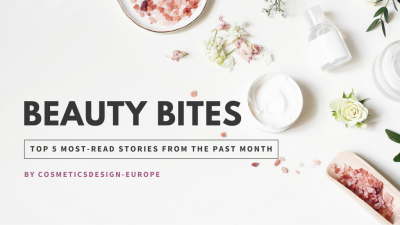Beauty backtracking: CosmeticsDesign-Europe’s 10 most-read stories of 2022

1. Garnier unveils 'no rinse' conditioner: We want to help change 'day-to-day beauty routines’, says president
In January, L’Oréal’s Garnier brand launched a no rinse conditioner line across Europe, in a move set to challenge consumers into re-thinking beauty routines and slash water use at mass scale. The launch formed part of its wider ‘Green Step’ beauty campaign.
Mathieu Richomme, sustainability project manager at Garnier, said: “The launch of the new ‘no rinse’ hair conditioner is about challenging the way we think about our daily routine and how we can make small changes, every day, to lessen our impact on the planet. If people want to be more sustainable then they need to be willing to make small changes to their lives – even if it means changing the way they wash their hair.”
Encouraging consumers to skip the rinse step traditionally associated with conditioners, he said, could considerably save water use at-home – around seven litres per wash.
2. Prill power: P&G files patent for dissolvable hair care pouches
In February, Procter & Gamble (P&G) filed an international patent on water-soluble pouches containing dissolvable hair care pellets, offering consumers a user-friendly, sustainable alternative to existing bottled and solid formats. The fibrous pouches dissolved quickly into a creamy product when in contact with hot water.
The company said the pouches offered many advantages compared to solid bars or prills that were often slow to dissolve or had melting issues during transport and storage. They were also less expensive to ship and easier to control, in dosage and delivery terms.
“When the pouch is exposed to water, the fibrous sheet(s) and water-soluble prills quickly dissolve into a homogenous, uniform, smooth, creamy, liquid personal care composition, such as a shampoo or a creamy conditioner. In some instances, the pouch seems to dissolve instantaneously,” P&G wrote in its patent.
3. ‘Clear, transparent and comparable’: Beauty giants launch EcoBeautyScore Consortium
In February, a group of beauty majors kickstarted the EcoBeautyScore Consortium with a vision to establish a brand-agnostic and transparent global environmental impact scoring system. Henkel, L’Oréal, LVMH, Natura &Co and Unilever had spearheaded the formation of the consortium when it was first announced back in September 2021.
“The consortium is open to all cosmetics and personal care companies, regardless of their size or resources (…) All companies will benefit from the pre-existing work and are invited to contribute with their own experience,” the companies said.
The goal was to empower consumers to make cross-brand comparisons on the environmental impact of beauty products, though the assessment and scoring system would be used on a “strictly voluntary basis” by consortium participants and other interested parties.
4. Future fragrances: Transparency, biotech and ‘feel-good’ perfumes to surge by 2024
In May, several fragrance industry experts detailed their vision of the future for the category, noting continued dynamism and innovations. Looking ahead, they said transparency, nostalgia and tech-forward formulations would gain importance, with many of these trends shaped by instabilities amidst the COVID-19 pandemic and ongoing political, environmental and financial crises.
Samira Boumédiène, head of global strategic marketing at Eurofragrance, said: “In general, when you have a crisis, people come back to the past because it’s something that they know and it’s a comfort.”
Feel-good perfumes, for example, would take centre stage in the coming years as consumers looked to integrate fragrance more holistically into their lives, she said.
Other experts said transparency would become key for fragrance consumers and biotechnology increasingly leaned on by industry.
5. Predicting hair loss: L’Oréal files patent on alopecia prognosis, diagnosis and treatment
In January, L’Oréal filed an international patent on a method it had developed to identify the molecular signature of a person’s scalp in a common alopecic state, enabling prognosis and diagnosis of hair loss. The company wanted to direct its invention towards predicting androgenetic alopecia in men, also known as male-pattern baldness.
L’Oréal said it had discovered that the expression of certain genes enabled a prognosis and/or diagnosis in a subject that could also be measured after a treatment designed to either induce or stimulate hair growth or slow down hair loss.
The longer-term goal, it said, was to offer efficacious cosmetic treatments for this – via topical and oral formulas or combined treatments.
“A treatment will be considered to have no effect if the expression levels of the chosen gene, before and after treatment, are substantially identical, or else if the differences observed are not significant,” L’Oréal wrote in its patent.
6. WGSN beauty ‘big ideas’ in 2024: Care culture, phygital, protopias, people power, accessibility and creativity
In May, trend forecaster WGSN unveiled its big ideas for beauty in 2024, highlighting six ideas that would define industry over the next two years: care-taking; fluid states; provoking protopias; people-power shifts; democra-sized; and code-breaking.
Clare Varga, director of beauty at WGSN, said: “Big ideas, for me, is the bridge between future consumer drivers and product creation. It really brings everything to life and helps people start to curate what products need to look like.”
Importantly, she said all six ideas were underpinned by a heightened sense of interdependence, a deeper yearning for community and a mainstream rejection of ‘normal’.
It would be critical, therefore, that beauty brands and retailers understood these shifts when working on product development projects or expansion.
7. Natural and organic cosmetics: An overview of certification options
In April, guest writer Tjaša Grum from CE.way Regulatory Consultants, outlined the raft of natural and organic cosmetic certification options taking on fresh importance in the wider green beauty boom. She warned, however, that there remained little regulation around these two terms.
“Cosmetics brands are well aware of the consumer interest in ‘green’ cosmetics, and the plethora of cosmetic products on the market clearly show that. But with little regulation around the terms ‘organic’ and ‘natural’, it can be difficult for consumers to know whether these products are indeed organic or natural or if everything is just a marketing move,” Grum wrote.
Highlighting the major certifications in the space, she said the NATRUE Label, COSMOS standard, BDIH certificate, ICEA certification, Soil Association certification, EU Ecolabel, and the ISO 16128 standard were all solid options for European beauty and personal care companies.
These, she said, played an “important role” in providing a guarantee to consumers.
8. Future of fragrance? Sustainability, neurosciences and digital innovation
In April, one fragrance expert said innovation in the category continued to push boundaries as expectations evolved around sustainability and functionality, with a fresh focus on mood-boosting and digital engagement.
Aitana Lopez de Carrion, global fine fragrance development manager at CPL Aromas, said there were four key movements shaping fragrances in 2022: sustainability, digital, smarter processing and functionality.
“Because of the situation we have [with COVID-19], we have been craving experiences now the world is opening up, and we’re looking for this joy, these experiences, enjoying life. And the lucky thing is, fragrances has always been this emotional trigger, so now is the best moment as a trend to use fragrances with purpose,” she said.
It was no longer about creating perfumes for their scent, she said, but about developing formulas with added functions, be that creating moods, feeling better, feeling relaxed or feeling more joyful.
9. Community, mindset and creativity: Estée Lauder, L’Oréal and Coty discuss future of the metaverse
In May, leading beauty executives from Estée Lauder, L’Oréal and Coty brainstormed the future of then metaverse, highlighting opportunities to engage, create and build communities.
Sarah Léa Chicheportiche, global prospective and global insights at Coty, said the creative side was especially interesting. “We can talk about NFTs and crypto but what’s interesting is being creators. We can recreate ourselves as avatars and that’s interesting and positive in then ideal metaverse,” she said.
And this ability to build “infinite identifies”, she said, could form part of a “joyful revolution” in the beauty space ahead.
Sam Cheow, SVP and global head of makeup innovation, portfolio and product development at The Estée Lauder Companies, agreed: “In the beauty industry, everyone (…) creates. We create the digital persona, makeup look, and mindset we are in.”
10. L’Oréal exec: The future of beauty packaging is ‘eco-desirability’
In March, L’Oréal’s global director of sustainable packaging Brice André discussed the future trends set to shape beauty packaging in the coming years, noting most would pivot around ‘eco-desirability’ – a blend of sustainability and desirability. And this was a space, he said, that L’Oréal was heavily focused on, with the refill-reuse design of its Valentino Rosso lipstick one good example.
“Beauty packaging will really be about high circularity, with two loops. The upstream circularity, which is about reuse and refill, so packaging doesn’t become waste too early, then downstream circularity where packaging becomes a resource through recycling and compostability,” André said.
However, the main consumer challenge moving forward, he said, would be ensuring the packaging was practical, performing and appealing. It would also be key that industry better aligned to achieve true progress, he said.
![The perceived value of a beauty product is now more important than ever for consumers, but it's not just about price [Getty Images]](/var/wrbm_gb_food_pharma/storage/images/_aliases/wrbm_medium/publications/cosmetics/cosmeticsdesign-europe.com/article/2023/03/09/mintel-says-value-key-in-beauty-during-cost-of-living-crisis-with-premiumisation-shopping-experiences-and-mood-key-trends/16238065-1-eng-GB/Mintel-says-value-key-in-beauty-during-cost-of-living-crisis-with-premiumisation-shopping-experiences-and-mood-key-trends.jpg)

![Consumers are increasingly invested in the health of their hair and are investing in the premium end of the market to achieve desired looks and outcomes [Getty Images]](/var/wrbm_gb_food_pharma/storage/images/_aliases/wrbm_medium/publications/cosmetics/cosmeticsdesign-europe.com/article/2023/02/14/l-oreal-ceo-says-hair-care-is-booming-as-consumers-show-interest-in-premium-luxury-products/16169579-1-eng-GB/L-Oreal-CEO-says-hair-care-is-booming-as-consumers-show-interest-in-premium-luxury-products.jpg)
![Underboob sweat, pimple popping, shaved heads and sexual health are just some of the topics consumers are diving into head-first this year as traditional beauty ideals unravel [Getty Images]](/var/wrbm_gb_food_pharma/storage/images/_aliases/wrbm_medium/publications/cosmetics/cosmeticsdesign-europe.com/headlines/market-trends/wgsn-beauty-trends-2023-highlights-unsexy-beauty-as-movement-to-watch-adding-to-mintel-nielseniq-and-verve/16077779-1-eng-GB/WGSN-beauty-trends-2023-highlights-unsexy-beauty-as-movement-to-watch-adding-to-Mintel-NielsenIQ-and-Verve.jpg)













![CosmeticsDesign’s editors on ingredients innovation at in-cosmetics Global 2024. [Getty Images]](/var/wrbm_gb_food_pharma/storage/images/_aliases/wrbm_tiny/publications/cosmetics/cosmeticsdesign-asia.com/article/2024/04/29/top-3-ingredients-innovations-at-in-cosmetics-global-2024/17376021-1-eng-GB/Top-3-ingredients-innovations-at-in-cosmetics-Global-2024.jpg)



